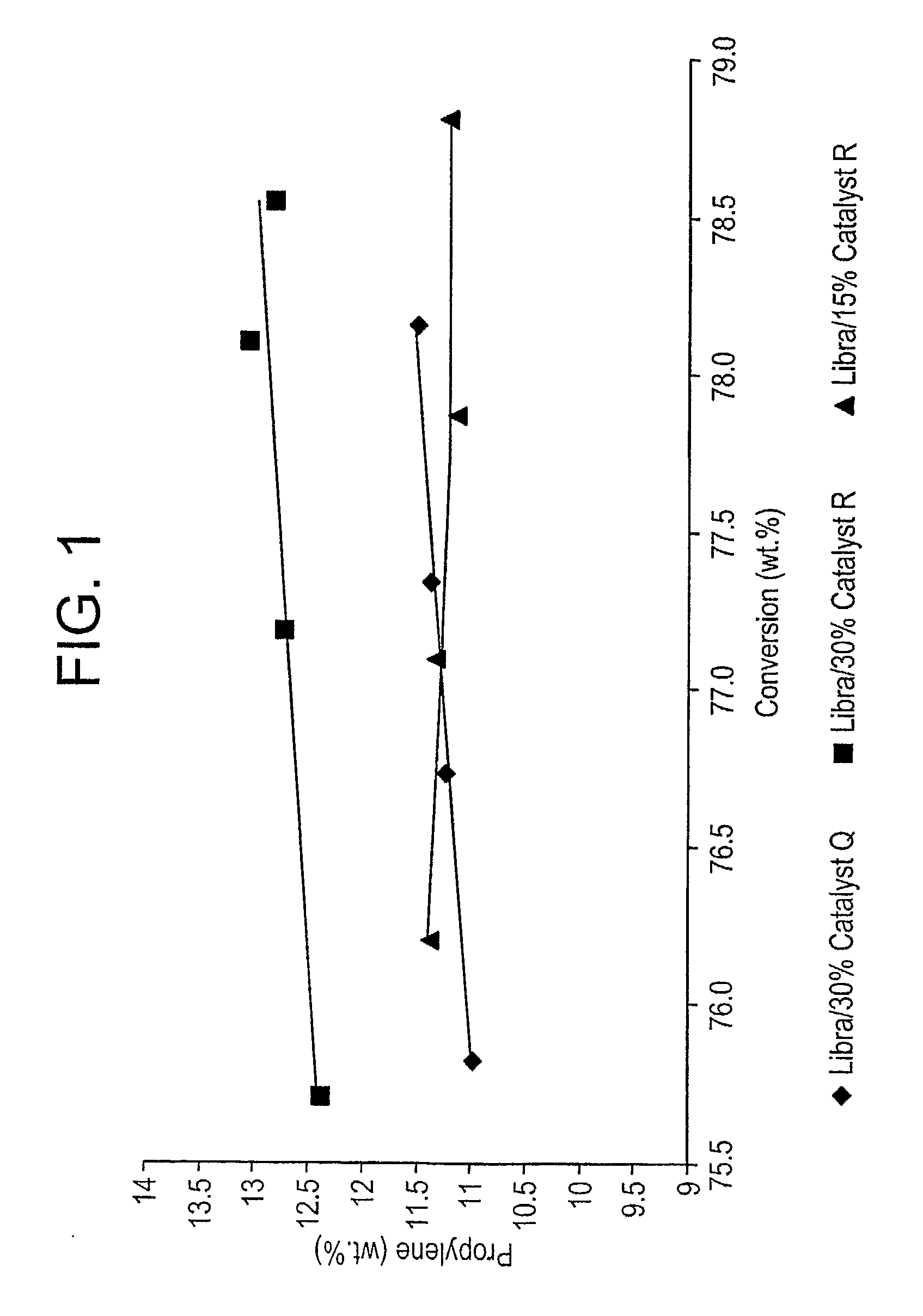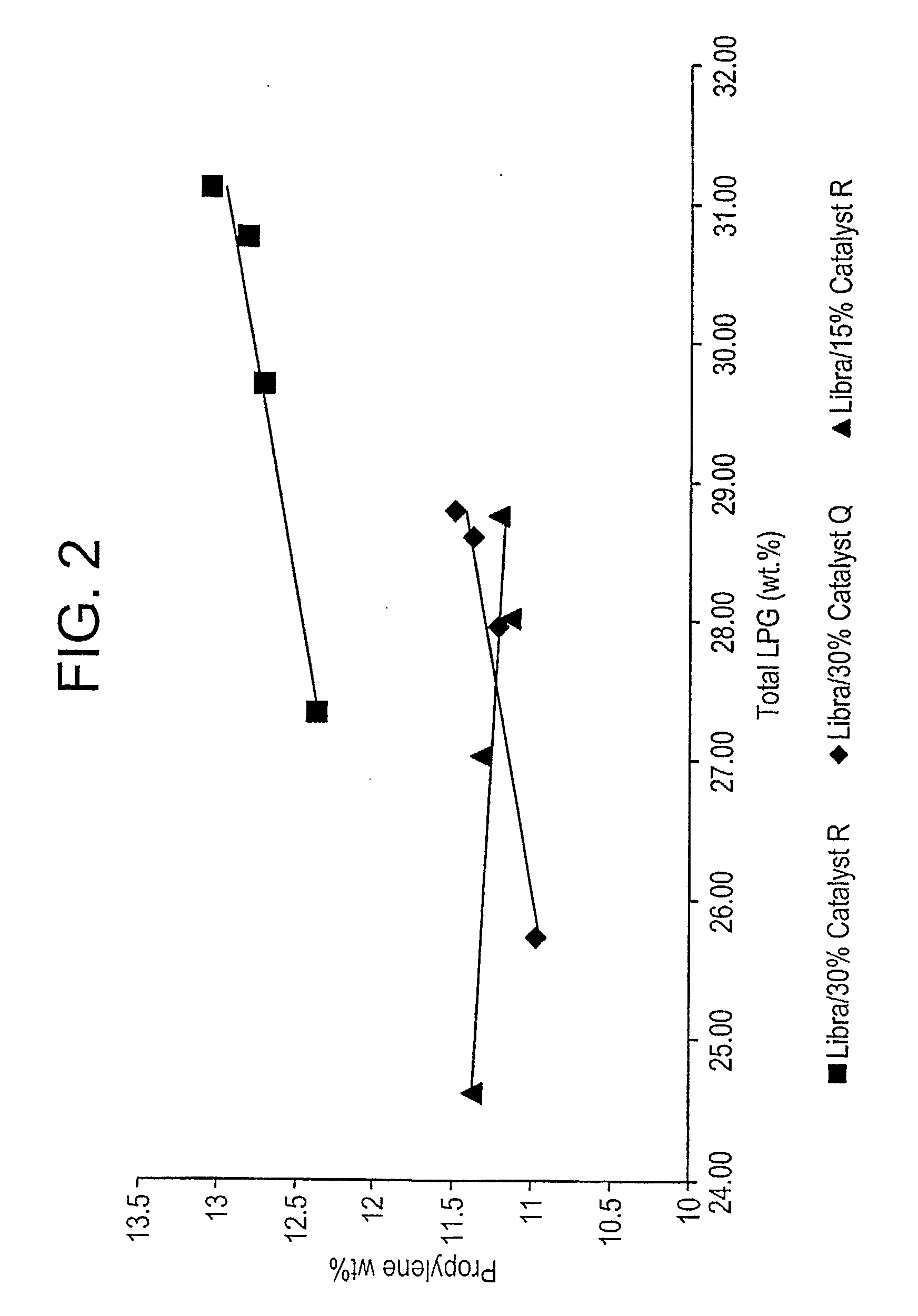Pentasil Catalyst for Light Olefins in Fluidized Catalytic Units
- Summary
- Abstract
- Description
- Claims
- Application Information
AI Technical Summary
Benefits of technology
Problems solved by technology
Method used
Image
Examples
example 1 (
Base)
[0097]A ZSM-5 catalyst was prepared as follows. ZSM-5 (4000 g dry basis) was slurried up in 12,000 g of deionized water. To this slurry was added aluminum chlorohydrol (200 grams Al2O3 dry basis), 400 g (dry basis) of Catapal-B™ alumina, 4200 g (dry basis) of kaolin clay and 1200 g of P2O5 from concentrated (85%) H3PO4. The slurry was mixed in a high shear mixer, milled in a 4 L Drais media mill at 1 L / min and then spray dried. The Bowen spray dryer was operated at a 400° C. inlet temperature and a 150° C. outlet temperature. The spray dried catalyst was calcined for 40 minutes at 593° C. This sample is designated Catalyst A and its properties are shown in Table 1.
Example 2 (1% Fe2O3)
[0098]A 1 wt % Fe2O3 containing ZSM-5 catalyst was prepared as follows. Fe2O3 powder (50 g) was slurried up in 5430 g of deionized water. To this mixture was added 600 g of P205 from concentrated (85%) H3PO4, 2000 g (dry basis) of ZSM-5, 100 g Al2O3 (dry basis) from aluminum chlorohydrol, 200 g (dr...
example 4
[0100]The catalysts in Examples 1-3 were tested in an ACE unit to determine their relative activities for producing propylene and LPG. The catalysts were steam deactivated for 24 hours at 816° C., 100% steam and blended at a 5% by weight level with a zeolite Y-containing Aurora™ cracking catalyst (available from W.R. Grace & Co. Conn.), which had been separately steamed for 4 hours at 816° C. [1500° F.], 100% steam. The catalysts blends were tested in an ACE Model AP Fluid Bed Microactivity unit at 527° C. Several runs were carried out for each catalyst using catalyst to oil ratios of between 3 and 10. The catalyst to oil ratio was varied by changing the catalyst weight and keeping the feed weight constant. The feed weight utilized for each run was 1.5 g and the feed injection rate was 3.0 g / minute. The properties of the feed are shown in Table 4. The interpolated propylene and LPG yields for the catalyst blend at a constant conversion of 77% are shown in Table 1. As can be seen, th...
example 5 (
Base Catalyst)
[0101]A ZSM-5 catalyst was prepared by making a slurry of 1364 grams (1200 grams dried basis) of ZSM-5 and 171 grams (120 grams dry basis) of Catapal B alumina in water to 32 wt % solids. To the slurry was added 279 grams (60 grams dry basis) of aluminum chlorohydrol, 1482 grams (1260 grams dry basis) of kaolin clay and 578 grams of concentrated H3PO4. The slurry was milled in a 4-liter Drais media mill at 1.2 liters / min. and then spray dried. The Bowen spray dryer was operated with a 400° C. inlet temperature and a 150° C. outlet temperature. The spray dried catalyst was calcined for 2 hours at 593° C. The properties of Catalyst D are shown in Table 2.
Example 6 (2% Fe2O3 from FeCl2)
[0102]Catalyst E, with 2wt% added Fe2O3, was prepared in the same manner as Example 5 with the exception that 149 grams of FeCl2·4H2O (60 grams Fe2O3 basis) was added to the slurry and the amount of kaolin clay was lowered to 1412 grams. The properties of Catalyst E are shown in Table 2.
Exa...
PUM
| Property | Measurement | Unit |
|---|---|---|
| Temperature | aaaaa | aaaaa |
| Temperature | aaaaa | aaaaa |
| Temperature | aaaaa | aaaaa |
Abstract
Description
Claims
Application Information
 Login to View More
Login to View More - R&D
- Intellectual Property
- Life Sciences
- Materials
- Tech Scout
- Unparalleled Data Quality
- Higher Quality Content
- 60% Fewer Hallucinations
Browse by: Latest US Patents, China's latest patents, Technical Efficacy Thesaurus, Application Domain, Technology Topic, Popular Technical Reports.
© 2025 PatSnap. All rights reserved.Legal|Privacy policy|Modern Slavery Act Transparency Statement|Sitemap|About US| Contact US: help@patsnap.com



